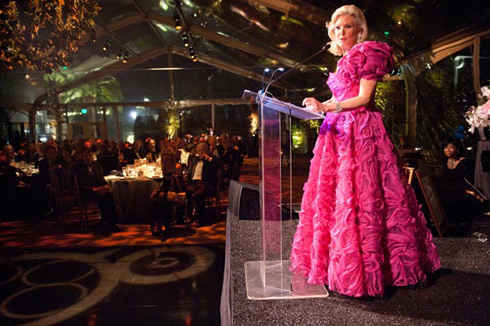The Business of Museums: Mismanagement at the de Young in San Francisco.

de Young Museum CEO Dede Wilsey. Courtesy: Panache Privée.
Ruth Osborne
We often forget that museums are a big business. They draw in millions annually, contribute billions to the national economy, transport major works of priceless artistic value miles around the globe, and provide jobs for hundreds of thousands in the U.S. alone.
Most of this work is done behind gallery walls – from conservation labs to accounting offices to research libraries. According to an AAM study, museums are also believed by visitors to be “one of the most trustworthy sources of objective information.” If we are to uphold the character of the museum as an expectedly trustworthy institution, then the public must also know what goes on behind the scenes.
Last month, news emerged surrounding a new financial scandal at the de Young Museum in San Francisco. The origin of the scandal was a complaint by the CFO of the Fine Arts Museums of San Francisco (the umbrella over the de Young and the Legion of Honor, proudly self-proclaimed as “the largest public arts institution in the City of San Francisco”). According to the CFO Michele Gutierrez, CEO of de Young and FAMSF Board President Dede Wilsey initiated an order to pay a retired staffer $450,000 for a “disability severance payment” sanctioned by the City Charter. This retiree, reportedly, already collects a $56,580 annual pension from the city. The payment was signed off by the Gutierrez but, she supposedly found out later, was not given final approval by the entire board before the check was issued. Mind you, the FAMSF is an institution that receive $16 million in city funding each year.
This was not the first time that the FAMSF have been in the news for mismanagement. In the past few years, the museums have gone through a series of high-profile firings, a wrongful termination lawsuit, a deaccession and sale against a living donor’s bequest, and another scandal involving items from Wilsey’s personal collection being handled and prepared for shipment during business hours on museum property and with museum personnel. For a museum that receives millions in public funds annually, especially in a climate in which arts funding is increasingly rare and precious, one would hope that such an institution is being run in an ethical manner.
Just a few days after news of this new scandal involving Wilsey hit the newsstands, the FAMSF issued a statement denying any wrongdoing on behalf of their CEO or the disapproval of her actions by the board at large. Their defensive statement appears to gloss over the large staff turnover that has occurred over the past year, arguing that as the result of recent evaluation by management consultants they have “[reorganized] the institution and [changed] personnel and job responsibilities.”
It should also be pointed out that, since Wilsey has been Board President two decades ago, sudden changes in its bylaws enabled the new president to remain without a term limit. These don’t seem like ideal procedures for a well-run public art collection. And yet, the FAMSF remained on the American Alliance of Museums’ list of accredited institutions in 2014.
Another accredited institution that has recently seen itself through financial mismanagement and shaming (it actually did receive an AAM sanction) is the Delaware Art Museum. News of the board’s bad stewardship over the collection – by means of selling art to make up for a bond debt – developed over the course of last year. The $19.5 million in debt was no doubt assisted by the $32.5 million the Museum shelled out for a 2005 expansion. As a result, the Museum took a blow to its artistic legacy as well as to future precedent for collections management practices.
With museums spending millions on expansions, additions to their collection, traveling exhibitions, transparency is not to be taken for granted. There is a higher and higher demand for institutions to be constantly spending in order to draw attention and relevance in an increasingly competitive art world. At the same time, those funding art institutions are failing to see their benefit to the local community and society as a whole, thus causing museums to strive to keep what little funding they have and remind people that art and history is relevant. The same week that this (most recent) scandal in SF emerged, the AAM announced it was putting the Illinois State Museums on probation as a result of their closure on September 30th after state budget decisions reached a stalemate. AAM Commission Chair Burt Logan took issue on how this closure would “impact […] the long-term viability of the museum, including affecting its ability to retain a professional staff and operate at the highest professional level […]”. The closure has caused museum staff to seek refuge for their collection during the interim, certainly not ideal care for the works being shuttled back and forth. The State Museum’s director of science Eric Grimm has commented on the situation that caused the closure: “It’s a travesty […] I think it’s political corruption and malevolent anti-intellectualism.” In an atmosphere like that of the past fifteen years, the need for greater oversight in the arts is becoming more and more evident.
By Ruth Osborne

